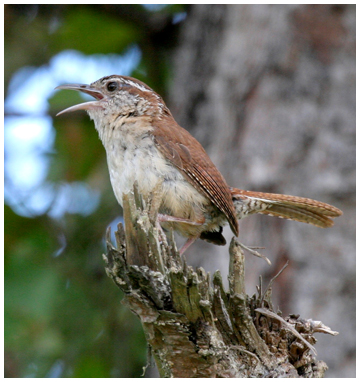
Commonly found in Walton County, the Carolina wren is a bird with many voices
By Jessica Basham, Florida Fish and Wildlife Conservation Commission
If you’ve ever wondered which bird sings the familiar, loud “doodalee, doodalee, doodalee” song, it is one of the most common backyard birds in Florida, the Carolina wren.
The Carolina wren is a lively little bird that often fluffs itself into a puffy, round shape to appear larger than its 6- or 7-inch body.
For its size, the male has one of the loudest voices of all birds.
This songbird can sing 27 to 47 different tunes and usually sings one repeatedly before switching to another. The male and female often sing together. If the birds feel scared or angry, their voice descends in sound, and they give a sharp “chirp!”
Carolina wrens are rusty brown on their upper body and wings and are light orange to tan on their underbelly. They have a white line above their eyes, almost like an eyebrow.
These birds aren’t shy around humans, so they build their nests almost anywhere – in shrubs, tree cavities, vines, potted plants and even empty boxes or mailboxes.
When a female wren chooses her lifetime mate, she also gets to pick a nest. That is because the male wren builds several nests made of sticks and twigs, usually near the ground. Once the female has picked her favorite, she fills it with soft things like grasses, leaves, fur, hair, feathers – whatever she can find. Female wrens lay three to seven dull-white eggs dusted with brown speckles. The small end of the egg usually has thicker brown spots that create a ring around the egg.
When the eggs hatch about two weeks later, sometimes the male feeds and cares for the young while the female goes to another nest and lays another set of eggs. These wrens can lay several clutches of eggs a year. The babies leave the nest 12 to 16 days later.
Carolina wrens like to hide in shrubs, vines and hedges. They especially like elderberry bushes, berry plants and Virginia creeper vines. They are always moving and are quick to stick their beaks into cracks and crevices of tree branches and tree trunks looking for tasty spiders and other bugs. They also love seeds and will visit bird feeders several times throughout the day, especially if there are sunflower seeds, peanuts or suet inside.
When you go out to listen and look for the Carolina wren, do not forget to grab binoculars and a bird journal, if you have started one. To become a bird detective and junior birder, visit floridabirdingtrail.com and select “Birding Resources” in the left-hand menu; then click on “Wings Over Florida.” That is where you can learn about the Junior Birder Program and can download a copy of the Bird Detective checklist. In addition, visit MyFWC.com/Learning for other fun wildlife activities.
